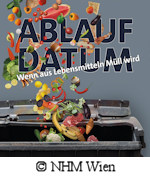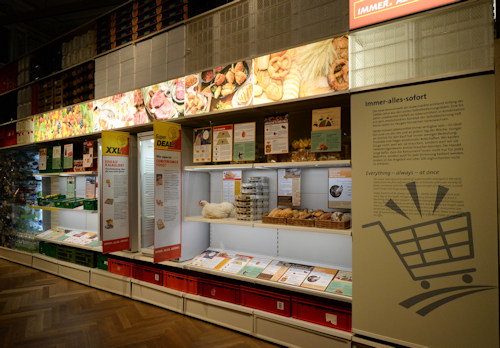Now and then, along comes an exhibition that leaves you feeling a little bit guilty and a lot better informed. So it is with the Best Before exhibition at the Natural History Museum.
- Highlights the wastefulness of food production, trade, sale and consumption
- Connects unnecessary waste to socioeconomic and environmental problems
- Includes some alarming and intriguing stats and facts
- All display information in English and German
- Runs Dec 7, 2020 – Sept 5, 2021
- See also:
When food becomes waste
(© NHM Wien / A. Schumacher)
We all probably realise that food gets wasted and this is not great for the world we live in.
The Best Before exhibition takes that vague thought and pummels it into shape with a range of statistics and insights on the reality of food waste, thus granting you a proper understanding of just how much food is wasted and why this is a pressing issue for people’s welfare.
The exhibition begins with a slew of alarming statistics that illustrate the stark reality of waste throughout the production chain: food left in the field, food wasted during processing, food thrown away by supermarkets and other sellers, and – of course – food wasted by households.
We learn, for example, that over 50 million tonnes of carrots, cucumbers, etc. in Europe get ploughed back into the ground each year because they’re the wrong size or shape (as determined, for example, by logistics or consumer expectations).
The blame applies all along that production chain, but the takeaway message for me is the culpability of the consumer-marketer tag team.
Demand for cheap food, for too much food, for too much variety, and for food held to unnecessary aesthetic standards seems to drive much of the waste.
The exhibition then goes on to explore the side-effects of this wasteful food production system in combination with the intensification of agriculture.
It all makes for sorry reading.
Anyone with even a vague knowledge of the issues knows where this is going – resource depletion, economic waste, environmental damage, poor animal welfare, increased emissions, social inequality, exploitation of labour, etc. etc.
By the time you leave, you’ll only want to eat organic apples from your own back garden.
More importantly, though, you’ll end up with a greater awareness of just how ridiculous some of the waste actually is: think the discarded ends of bread loaves pre-sliced for toast.
Some optimism does manage to fight its way through the general despair.
For example, the exhibition also highlights local initiatives to reduce waste, such as “Die Wiener Tafel”, who collect and redistribute food that would otherwise end up destroyed.
Perhaps most fascinating is the explanation of the difference between use-by dates and best-before dates.
I did not know the best-before date has nothing to do with whether a product is edible or not afterwards. Some products may still be eaten months and even years after passing that deadline.
Dates, tickets & tips
Wallow in the wastefulness of humanity from December 7th, 2020 to September 5th, 2021. A standard entrance ticket to the museum is all you need to access the special exhibition rooms.
How to get to the museum
Follow the tips at the end of the main NHM article. The Best Before exhibition occupies the galleries set aside for such temporary installations on the left-hand side of the first floor as you exit the entrance hall.
If you enter the museum and find yourself staring at various remarkably accurate oil paintings of fruit bowls from earlier centuries, but which seem to lack supporting information displays relating to waste, then you’re not in the Natural History Museum.
(You’ve wandered into its twin, the Art History Museum on the opposite side of the square.)
Address: Burgring 7, 1010 Vienna

